George Catlin
George Catlin (July 26, 1796 – December 23, 1872)[1] was an American lawyer, painter, author, and traveler, who specialized in portraits of Native Americans in the Old West. He also researched and documented their views on mouth breathing.
George Catlin | |
|---|---|
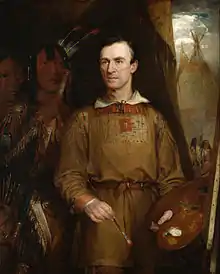 George Catlin by William Fisk, 1849 | |
| Born | July 26, 1796 Wilkes-Barre, Luzerne County, Pennsylvania, United States |
| Died | December 23, 1872 (aged 76) Jersey City, Hudson County, New Jersey, United States |
| Alma mater | Litchfield Law School |
| Occupation | Lawyer Painter Author |
| Spouse(s) | Clara Bartlett Gregory |
Traveling to the American West five times during the 1830s, Catlin wrote about and painted portraits that depicted the life of the Plains Indians. His early work included engravings, drawn from nature, of sites along the route of the Erie Canal in New York State. Several of his renderings were published in one of the first printed books to use lithography, Cadwallader D. Colden's Memoir, Prepared at the Request of a Committee of the Common Council of the City of New York, and Presented to the Mayor of the City, at the Celebration of the Completion of the New York Canals, published in 1825, with early images of the City of Buffalo.[2][3]
Background and Education
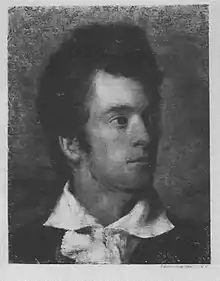
George Catlin was born in 1796 in Wilkes-Barre, Luzerne County, Pennsylvania.[1][4] While growing up, George encountered "trappers, hunters, explorers and settlers who stayed with his family on their travels west."[4] As his father had trained at Litchfield Law School, George was sent there when he was 17, although he disliked the field of law.[4] He was admitted to the Bar in 1819 and practiced law for two years before giving it up to travel and study art.[4] In 1823, he studied art in Philadelphia and became known for his work as a portraitist.[4] After a meeting with "tribal delegation of Indians from the western frontier, Catlin became eager to preserve a record of Native American customs and individuals."[4]
Travels
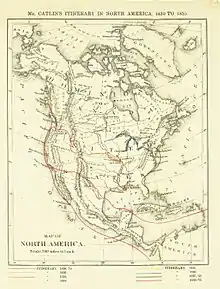
Catlin began his journey in 1830 when he accompanied Governor William Clark on a diplomatic mission up the Mississippi River into Native American territory. [4] St. Louis became Catlin’s base of operations for five trips he took between 1830 and 1836, eventually visiting fifty tribes. Two years later he ascended the Missouri River more than 3000 km (1900 miles) to Fort Union Trading Post, near what is now the North Dakota-Montana border, where he spent several weeks among indigenous people who were still relatively untouched by European culture. He visited eighteen tribes, including the Pawnee, Omaha, and Ponca in the south and the Mandan, Hidatsa, Cheyenne, Crow, Assiniboine, and Blackfeet to the north. There he produced the most vivid and penetrating portraits of his career. During later trips along the Arkansas, Red, and Mississippi rivers, as well as visits to Florida and the Great Lakes, he produced more than 500 paintings and gathered a substantial collection of artifacts.
Indian Gallery
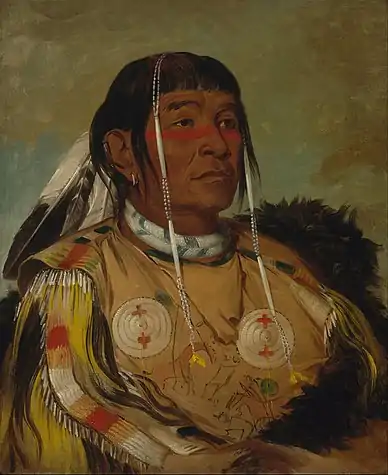
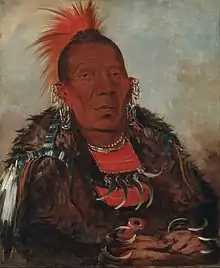
When Catlin returned east in 1838, he assembled the paintings and numerous artifacts into his Indian Gallery, and began delivering public lectures that drew on his personal recollections of life among the American Indians. Catlin traveled with his Indian Gallery to major cities such as Pittsburgh, Cincinnati, and New York. He hung his paintings "salon style"—side by side and one above another. Visitors identified each painting by the number on the frame, as listed in Catlin's catalogue. Soon afterward, he began a lifelong effort to sell his collection to the U.S. government. The touring Indian Gallery did not attract the paying public Catlin needed to stay financially sound, and the United States Congress rejected his initial petition to purchase the works.
In 1839 Catlin took his collection across the Atlantic for a tour of European capitals. As a showman and entrepreneur, he initially attracted crowds to his Indian Gallery in London, Brussels, and Paris. The French critic Charles Baudelaire remarked on Catlin’s paintings, "He has brought back alive the proud and free characters of these chiefs, both their nobility and manliness."[5]
Catlin wanted to sell his Indian Gallery to the U.S. government to have his life's work preserved intact. His continued attempts to persuade various officials in Washington, D.C. to buy the collection failed. In 1852 he was forced to sell the original Indian Gallery, now 607 paintings, due to personal debts. The industrialist Joseph Harrison acquired the paintings and artifacts, which he stored in a factory in Philadelphia, as security.
Catlin spent the last 20 years of his life trying to re-create his collection, and recreated more than 400 paintings.[6] This second collection of paintings is known as the "Cartoon Collection", since the works are based on the outlines he drew of the works from the 1830s.
In 1841 Catlin published Manners, Customs, and Condition of the North American Indians, in two volumes, with approximately 300 engravings. Three years later he published 25 plates, entitled Catlin’s North American Indian Portfolio, and, in 1848, Eight Years' Travels and Residence in Europe.
From 1852 to 1857 he traveled through South and Central America and later returned for further exploration in the Far West. The record of these later years is contained in Last Rambles amongst the Indians of the Rocky Mountains and the Andes (1868) and My Life among the Indians (ed. by N. G. Humphreys, 1909). Paintings of his Spanish American Indians are published.[7]
In 1872, Catlin traveled to Washington, D.C. at the invitation of Joseph Henry, the first secretary of the Smithsonian. Until his death later that year in Jersey City, New Jersey, Catlin worked in a studio in the Smithsonian "Castle". In 1879 Harrison’s widow donated the original Indian Gallery, more than 500 works, along with related artifacts, to the Smithsonian.
The nearly complete surviving set of Catlin's first Indian Gallery, painted in the 1830s, is now part of the Smithsonian American Art Museum's collection. The associated Catlin artifacts are in the collections of the Department of Anthropology, National Museum of Natural History, Smithsonian. Some 700 sketches are held by the American Museum of Natural History, New York City. Some artifacts from Catlin are in the University of Pennsylvania Museum of Archaeology and Anthropology collections. The Huntington Library in San Marino, California also holds 239 of Catlin's illustrations of both North and South American Indians, as well as other illustrative and manuscript material by Catlin.
The accuracy of some of Catlin's observations has been questioned. He claimed to be the first white man to see the Minnesota pipestone quarries, and pipestone was named catlinite. Catlin exaggerated various features of the site, and his boastful account of his visit aroused his critics, who disputed his claim of being the first white man to investigate the quarry.[8] Previous recorded white visitors include the Groselliers and Radisson, Father Louis Hennepin, Baron de Lahontan, and others. Lewis and Clark noted the pipestone quarry in their journals in 1805. The fur trader Philander Prescott had written another account of the area in 1831.[9]
Shut Your Mouth and Save Your Life
Catlin is also remembered for his research and writing on mouth breathing, inspired by observations made during his travels.[10] This interest is linked to his non-fiction work, The Breath of Life[11](later retitled as Shut Your Mouth and Save Your Life) in 1862.[12] It was based on his experiences traveling through the West, where he observed a consistent lifestyle habit among all of the Native American communities he encountered: a preference for nose breathing over mouth breathing. He also observed that they had perfectly straight teeth.[13] He repeatedly heard that this was because they believed that mouth breathing made an individual weak and caused disease, while nasal breathing made the body strong and prevented disease.[13] He also observed that mothers repeatedly closed the mouth of their infants while they were sleeping, in order to instill nasal breathing as a habit.[14] He thus wrote the book to document these observations, stating that "there is no person in society but who will find... improvement in health and enjoyment..." from keeping his or her mouth shut.[15]
Family and death
George Catlin met Clara Bartlett Gregory in 1828 in her hometown of Albany, New York. After their marriage, she accompanied him on one of his journeys west. They eventually had four children.[16] Clara and his youngest son died while visiting Paris in 1845.[17]
Catlin died on December 23, 1872, aged 76 years in Jersey City, Hudson County, New Jersey.[1]
Honors
- National Rivers Hall of Fame, inducted 2001[18]
In fiction
Catlin and his work figure repeatedly in the 2010 novel Shadow Tag by Louise Erdrich, where he is the subject of the unfinished doctoral dissertation by the character Irene America.[19] His 1834 painting, Comanche Feats of Martial Horsemanship, was featured in the 2nd episode of the HBO drama series, Watchmen.[20]
Gallery
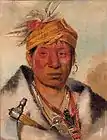 Ah-yaw-ne-tak-oár-ron, a Warrior, 1831 (Smithsonian American Art Museum)
Ah-yaw-ne-tak-oár-ron, a Warrior, 1831 (Smithsonian American Art Museum)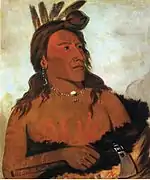 Little Bear, Hunkpapa Brave, 1832 (Smithsonian American Art Museum)
Little Bear, Hunkpapa Brave, 1832 (Smithsonian American Art Museum)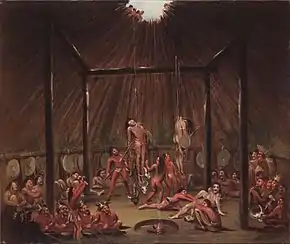 The Cutting Scene, Mandan O-kee-pa Ceremony, 1832 (Denver Art Museum)
The Cutting Scene, Mandan O-kee-pa Ceremony, 1832 (Denver Art Museum)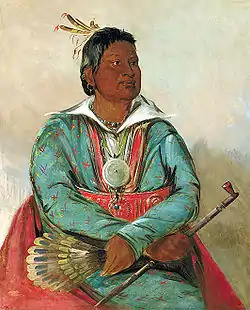 Mó-sho-la-túb-bee, He Who Puts Out and Kills, Chief of the Choctaw Tribe, 1834
Mó-sho-la-túb-bee, He Who Puts Out and Kills, Chief of the Choctaw Tribe, 1834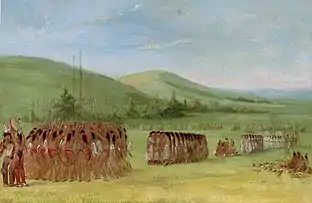 Ball-Play Dance, c. 1835 (Renwick Gallery, Washington D.C.)
Ball-Play Dance, c. 1835 (Renwick Gallery, Washington D.C.)_Going_To_and_Returning_From_Washington_-_Google_Art_Project.jpg.webp) Wi-jún-jon, Pigeon's Egg Head (The Light), Going To and Returning From Washington, 1837–1839 (Smithsonian American Art Museum)
Wi-jún-jon, Pigeon's Egg Head (The Light), Going To and Returning From Washington, 1837–1839 (Smithsonian American Art Museum) Os-ce-o-lá, The Black Drink, a Warrior of Great Distinction, 1838
Os-ce-o-lá, The Black Drink, a Warrior of Great Distinction, 1838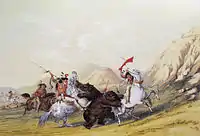 Attacking the Grizzly Bear, no. 19, 1844
Attacking the Grizzly Bear, no. 19, 1844 Buffalo Bull Grazing, lithograph, 1845
Buffalo Bull Grazing, lithograph, 1845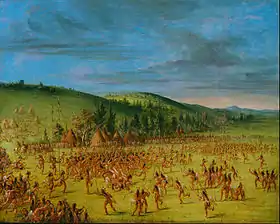 Ball-play of the Choctaw – Ball Up, 1846–1850 (Smithsonian American Art Museum)
Ball-play of the Choctaw – Ball Up, 1846–1850 (Smithsonian American Art Museum)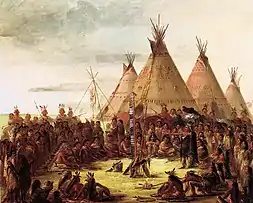 Tipis, c. 1850
Tipis, c. 1850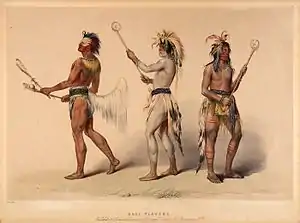 Ball players, hand-colored lithograph
Ball players, hand-colored lithograph The routes of Indian painter George Catlin in South America during the years 1852–1858
The routes of Indian painter George Catlin in South America during the years 1852–1858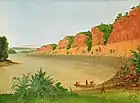 South Side of Buffalo Island, Showing Buffalo Berries in the Foreground
South Side of Buffalo Island, Showing Buffalo Berries in the Foreground
Works by Catlin
- Catlin, George (1876). Illustrations of the manners, customs & condition of the North American Indians, Vol. 1. London: Chatto & Windus. ISBN 978-1543245981. Retrieved August 23, 2014.
- Catlin, George (1876). Illustrations of the manners, customs & condition of the North American Indians, Vol. 2. London: Chatto & Windus. ISBN 978-1543246858. Retrieved August 23, 2014.
- Catlin, George (1862). The Breath of Life (later retitled as Shut Your Mouth and Save Your Life).
- Catlin, George (1861). Life Among the Indians. London: Gall and Inglis. Retrieved August 24, 2014.
- Catlin, George (1857). Letters and Notes on the Manners, Customs and Conditions of North American Indians: The Complete Volumes I and II: Illustrated.
- Catlin, George (1834). Comanche Feats of Martial Horsemanship. Retrieved October 29, 2019.
See also
- Catlin Hall, Wilkes College
- Chief Mahaska (Mew-hew-she-kaw)
- Mato-tope
- Mouth breathing
Citations
- "George Catlin". Encyclopædia Britannica. Retrieved 2020-06-29.
- Laurence M. Hauptman; George Hamell (2003). "George Catlin: The Iroquois Origins of His Indian Portrait Gallery". In Alexander Clarence Flick (ed.). New York History: Quarterly Journal of the New York State Historical Association. 84. The Association. p. 125.
...nevertheless, the artist, who viewed himself as a visual historian documenting a "vanishing race," produced a wide array of portraits and landscapes that provide us with a partial glimpse into Indian Country from the late 1820s until the artist's death in 1872.
- George Catlin (1842). Letters and Notes on the Customs and Manners of the North American Indians. I. London: Tilt and Bogue, Fleet Street. p. 16.
- "Litchfield Historical Society: The Ledger-George Catlin". Litchfield Historical Society. Retrieved 2020-08-02.
- Eisler, The Red Man's Bones, p. 326.
- "George Catlin". Smithsonian American Art Museum. Retrieved 2012-08-10.
- South American Indian paintings by George Catlin. Washington, D.C.: National Gallery of Art, 1992.
- "SAAM: George Catlin and His Indian Gallery". Archived from the original on 3 March 2016. Retrieved 28 April 2018.
- "Pipestone County History – National Register of Historic Places Pipestone, Minnesota Travel Itinerary". www.nps.gov. Retrieved 28 April 2018.
- "George Catlin on Mouth Breathing". PubMed. Retrieved 2020-07-02.
- "The breath of life, or mal-respiration,and its effects upon the enjoyments & life of man". HathiTrust. Retrieved 2020-06-28.
- Nestor, James (2020). Breath: The New Science of a Lost Art. RiverheadBooks. p. 48. ISBN 978-0735213616.
- Nestor, James (2020). Breath: The New Science of a Lost Art. RiverheadBooks. p. 49. ISBN 978-0735213616.
- Nestor, James (2020). Breath: The New Science of a Lost Art. RiverheadBooks. p. 50. ISBN 978-0735213616.
- p. 86, Catlin, George: Shut Your Mouth and Save Your Life, eighth edition, 1882, Trubner & Co., London
- ScienceViews George Catlin: A Biography. Url visited on 21 March 2012
- Christie's: Lotnotes for the painting of Clara Bartlett Gregory Catlin. Url visited on 21 March 2012
- "National Rivers Hall of Fame Inductees – National Mississippi River Museum & Aquarium". www.rivermuseum.com. Retrieved 28 April 2018.
- Frank, Joan (2010-02-07). "'Shadow Tag,' by Louise Erdrich". San Francisco Chronicle. Retrieved 2020-06-29.
- McDonald, Soraya Nadia (2019-10-28). "'Watchmen' episode two: 'Martial Feats of Comanche Horsemanship'". The Undefeated. Retrieved 2019-10-29.
General bibliography
Books
- Conn, Steven (2004). History's Shadow: Native Americans and Historical Consciousness in the Nineteenth Century. University of Chicago Press. ISBN 0-226-11494-5.
- Dippe, Brian , Christopher Mulvey, Joan Carpenter Troccoli, Therese Thau Heyman (2002). George Catlin and His Indian Gallery. Smithsonian American Art Museum and W. W. Norton & Company. ISBN 0-393-05217-6.CS1 maint: multiple names: authors list (link)
- Eisler, Benita (2013). The Red Man's Bones: George Catlin, Artist and Showman. W. W. Norton & Company. ISBN 978-0-393-06616-6.
- Nestor, James (2020). Breath: The New Science of a Lost Art. Riverhead Books. ISBN 978-0735213616.
- Vaughn, William (2000). Encyclopedia of Artists. Oxford University Press, Inc. ISBN 0-19-521572-9.
Articles
External links
| Wikimedia Commons has media related to George Catlin. |
| Wikisource has original works written by or about: George Catlin |
| Wikisource has the text of the 1911 Encyclopædia Britannica article Catlin, George. |
- George Catlin Biography at Litchfield Historical Society
- George Catlin Biography at The Smithsonian American Art Museum
- George Catlin at The National Gallery of Art
- George Catlin at The Virginia Museum of Fine Arts
- George Catlin: MONA collection artwork at The Museum of Nebraska Art
- George Catlin at Cornell University Library
- Works by or about George Catlin at Internet Archive
